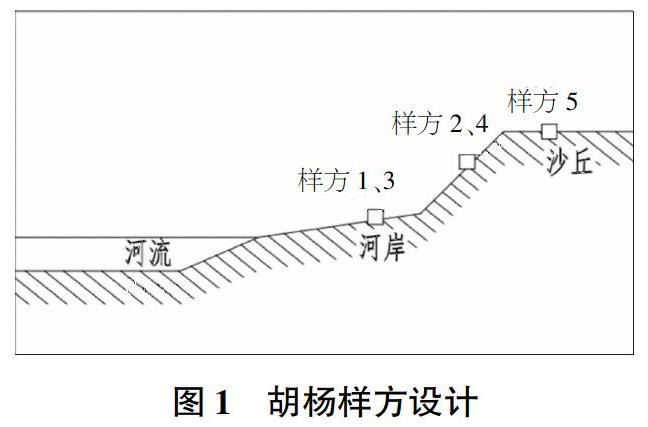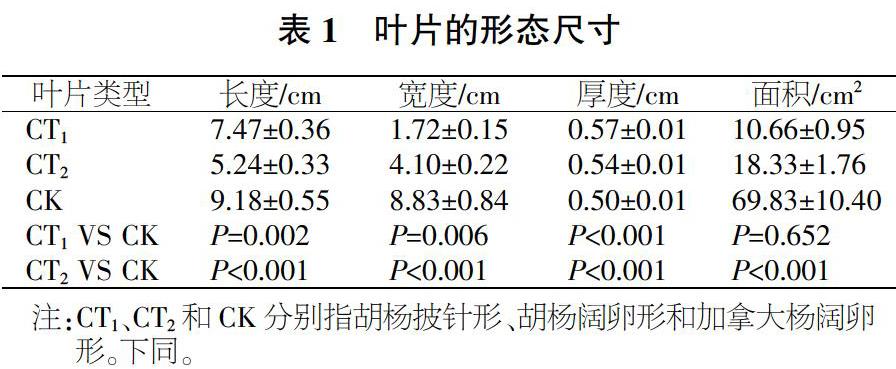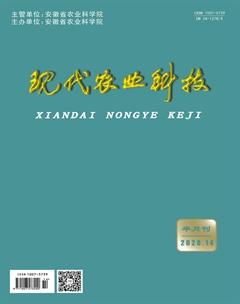干旱环境下胡杨叶片形态和微观特征的研究
熊远猇 万宇轩 马丽霞



摘要 为了探究胡杨应对干旱的适应机制,本研究从宏观方面对叶片形态和面积进行观察,到微观角度对栅栏组织细胞、气孔分布等进行观察,对比分析胡杨过渡类型叶片(胡杨披针形叶片、胡杨阔卵形叶片)和加拿大杨阔卵形叶片的差异性。结果表明,胡杨冠层叶片叶形种类多、表面蜡质皮质层厚、气孔稀疏且下陷、叶脉密度大、碳含量高等特点为胡杨在干旱条件下生存提供了生理基础;同时,确定了维持胡杨节流储水功能的内部和外部形态结构特点,揭示了胡杨应对干旱的适应机制。
关键词 胡楊;叶片形态;微观特征;抗旱机制
中图分类号 S792.119 文献标识码 A
文章编号 1007-5739(2020)14-0110-03
Abstract In order to explore the response mechanisms of Populus euphratica to drought, this study observed the leaf morphology and area from the macro perspective, and observed the palisade tissue cells, stomatal distribution and so on from the micro perspective, compared and analyzed the differences between transition type leaves of Populus euphratica (lanceolate leaves and broadly ovate leaves of Populus euphratica) and broadly ovate leaves of Canadian poplar. The results showed that the characteristics of Populus euphratica, such as multiple leaf forms, thick waxy cortex layer, sparse stomata and subsidence, large leaf vein density and high carbon content, provided physiological basis for Populus euphratica to survive under drought conditions. At the same time, the study determined the characteristics of internal and external morphological structure that maintained the function of water storage and throttling, and revealed the mechanism of adaptation to drought.
Key words Populus euphratica; leaf morphology; microscopic characteristic; drought resistance mechanism
胡杨(Populus euphratica)是杨柳科杨属植物,生长于温带大陆性气候,适应干旱的荒漠环境,在内蒙古额济纳旗生长面积广泛[1]。胡杨夏季日耗水量为20~30 kg/株,春秋季为10~20 kg/株,冬季<10 kg/株。目前,环境保护是世界范围内广泛关注的话题,胡杨抗旱性强的特点引起研究者的关注。本研究旨在从叶片形态到微观特征等方面研究胡杨应对干旱的机理,为环境保护及植物微观结构研究工作提供参考。
1 材料与方法
1.1 试验材料
试验材料选取胡杨叶片250片(采自额济纳旗)、加拿大杨叶片250片(采自北京市一〇一中学校园)。
1.2 样方设计
从河岸到沙丘顶部选取5个10 m×10 m样方,样方1、3位于距河道50~150 m的岸边,样方2、4位于沙丘中部,样方5位于沙丘顶部(图1)。共调查834株胡杨,其中770株存活、64株死亡。老年、中年和幼年胡杨分别为52、563、155株。
1.3 试验方法
1.3.1 叶片形态特征及尺寸。每个样方选取3株胡杨树,按高度将树冠划分为不同的层面,观察每一层叶片的形态及分布特征。取叶片,制作临时装片,放在Axio Imager.Z2型正置显微镜下观察横切面。用直尺测量叶片尖端到基部的长度(叶长)和叶片的最宽处(叶宽),用游标卡尺测定叶片厚度,计算叶片面积。计算公式如下:
叶片面积=叶长×叶宽/1.2(1)
1.3.2 确定气孔形态和气孔密度。在叶片的上下表皮随机选取5个区域,通过显微镜观察叶片上下表皮的气孔分布,测量区域面积并统计气孔数量,确定气孔密度。将指甲油均匀涂抹在叶片表面,晾干后撕掉,表皮随即被撕下。将表皮置于载玻片上,通过显微镜观察单个气孔的形态,利用标尺测量气孔长度,重复5次。
1.3.3 维管束和栅栏组织形态观察。取叶送至武汉谷歌生物科技公司,制作石蜡切片,观察维管束和栅栏组织形态。

